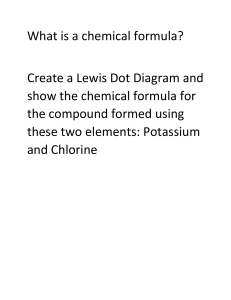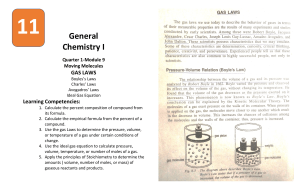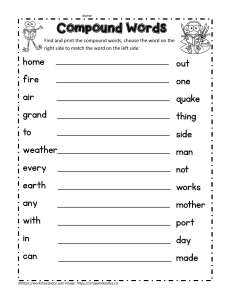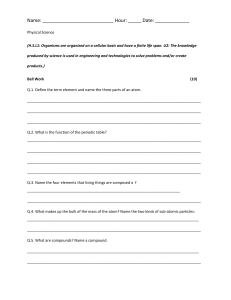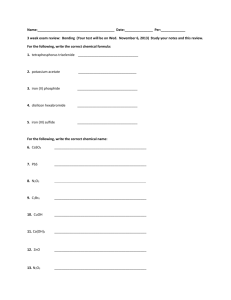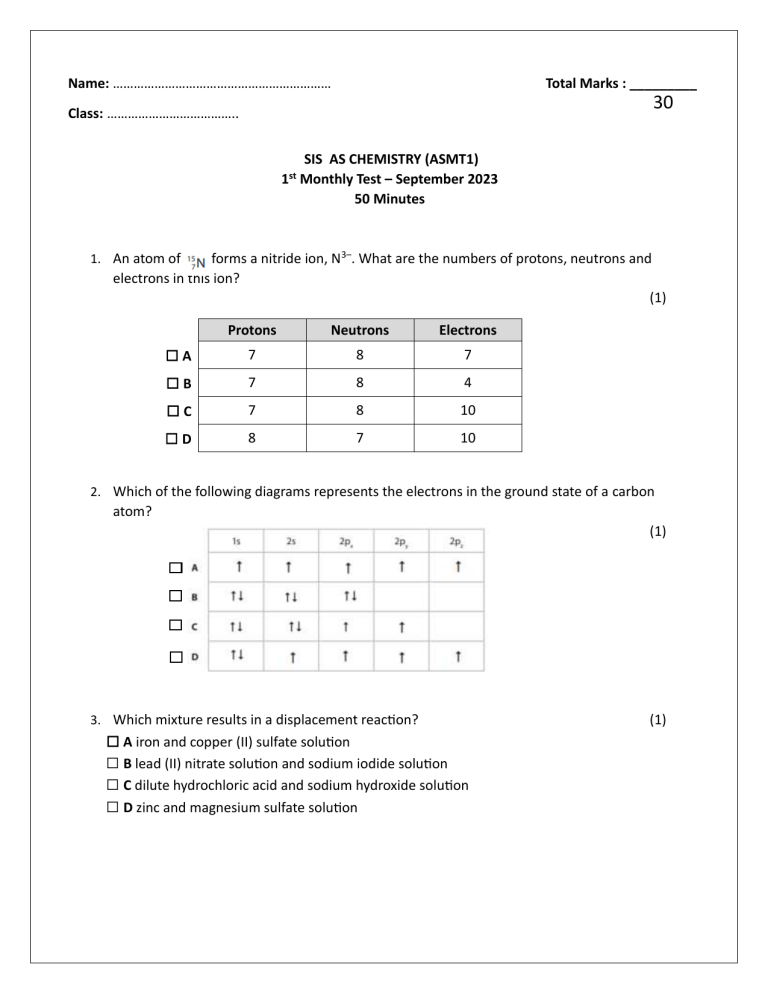
Name: ……………………………………………………… Total Marks : _________ 30 Class: ……………………………….. 1st SIS AS CHEMISTRY (ASMT1) Monthly Test – September 2023 50 Minutes forms a nitride ion, N3–. What are the numbers of protons, neutrons and electrons in this ion? (1) 1. An atom of Protons Neutrons Electrons ⃣ A 7 8 7 ⃣ B 7 8 4 ⃣ C 7 8 10 ⃣ D 8 7 10 2. Which of the following diagrams represents the electrons in the ground state of a carbon atom? (1) 3. Which mixture results in a displacement reaction? ⃣ A iron and copper (II) sulfate solution ⃣ B lead (II) nitrate solution and sodium iodide solution ⃣ C dilute hydrochloric acid and sodium hydroxide solution ⃣ D zinc and magnesium sulfate solution (1) 4. Which mixture results in a precipitation reaction? (1) ⃣ A dilute sulfuric acid and potassium hydroxide solution ⃣ B iron and calcium chloride solution ⃣ C chlorine water and potassium bromide solution ⃣ D silver nitrate solution and potassium bromide solution 5. Mass spectrometers are used in chemical analysis. (a) In which region of this mass spectrometer are the ions accelerated? ⃣ A region P ⃣ B region Q ⃣ C region R (1) ⃣ D region S (b) Which of these ions will follow path 1 through the mass spectrometer? ⃣ A 54Fe+ ⃣ B 54Fe2+ ⃣ C 56Fe+ (1) ⃣ D 56Fe2+ c) Naturally-occurring chlorine has two isotopes, 35Cl and 37Cl. How many peaks due to the singlycharged molecular ions are seen in the mass spectrum of chlorine, Cl2? (1) ⃣ A1 ⃣ B2 ⃣ C3 ⃣ D4 6. This question is about the Group 4 element germanium and some of its compounds. (a) Naturally-occurring germanium consists of five stable isotopes. Explain what is meant by the term isotopes. (2) …………………………………………………………………………………………………………………………………………………… …………………………………………………………………………………………………………………………………………………… (b) The mass spectrum of a sample of germanium is shown. Calculate the relative atomic mass of this sample of germanium. (2) (c) Give the electronic configuration of a germanium atom. (1) …………………………………………………………………………………………………………………………………………………… (d) Germane is a compound with the formula GeH4. It can be formed by the reaction shown. (i) Calculate the atom economy, by mass, for the formation of germane. (2) Use Ar of Ge = 72.6 (ii) Germane is toxic and the maximum permitted concentration is 0.640mgm–3 in air. Calculate the maximum number of germane molecules permitted in a laboratory with a volume of 231 m3. [Avogadro constant (L) = 6.02×1023mol–1] (4) (e) A halide of germanium, GeX4, reacts with water as shown. 1.50g of GeX4 was added to excess water. The insoluble GeO2 was removed by filtration. The solution of hydrogen halide formed was then added to excess magnesium carbonate, forming 335.5cm3 of carbon dioxide at room temperature and pressure (r.t.p.). [Molar volume of a gas at r.t.p. = 24000cm3 mol–1] (i) Calculate the number of moles of carbon dioxide formed. (1) (ii) Deduce the number of moles of HX formed when GeX4 reacted with the excess water. (1) (iii) Deduce the number of moles of GeX4 that reacted with the excess water. (iv) Calculate the molar mass of GeX4 and hence identify X. (1) (2) (Total for Question 6 = 16 marks) 7. A component of petrol, compound X, contains 92.3% carbon and 7.7% hydrogen by mass. (i) Calculate the empirical formula of compound X. You must show all your working. (2) (ii) A sample of compound X has a mass of 0.267g and vaporises at 85.0°C and 104kPa to produce a gaseous sample with a volume of 98.0cm3 . Calculate the molar mass of compound X. You must show all your working. [ pV = nRT R = 8.31Jmol–1K–1] (ii) (4) Deduce the molecular formula of compound X, using your answers to (d)(i) and (d)(ii). (1) (Total for Question 7 = 7 marks)


